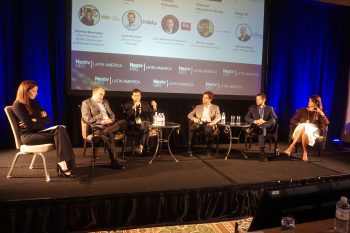BUSINESS / EVENTS
With a program that included 24 panel and interview offerings during November 5 and 6 in Miami, the event organized by Dataxis concluded

Mónica González Piriz, Nicolas Coates, Mariano Varela, Juan Martinez, Luis Guillermo Villanueva and Dione Bermudez.
Issues that concern the community of cable operators, programmers and technology developers were addressed by industry leaders in the region.
The specialists shared their ideas and experiences at the Biltmore Hotel, of Coral Gables in Miami, with the presentation as every year by Ariel Barlaro, VP Americas of the French consultant Dataxis.
The first panel was about the transformation of Pay TV Operators, with Bruno Pruneda, General Director of StarTV satellite service in Mexico; Fabiana Orlotti, CEO of Montecable of Uruguay, Javier Ruete, COO of TCC of Uruguay and Mauro Peluso, Co-Founder and Board Director of Toolbox. The discussion focused on the challenges of individual consumption versus traditional modalities, excessive advertising load, “packages” online content and OTTs. The conclusion was that the OTTs are evolving at five different speeds: programmers, operators and three at the client level facing problems such as rights, although there has been a maturation process in programmers with a certain brake on the change of individual delivery.
Another of the interesting panels was how to deploy a direct service to the consumer, with Alexander Marín, EVP of Distribution and Networks for Latin America, the Caribbean and Canada of Sony Pictures Television (SPT) and Eduardo Ruiz, president of A+E Latin America, who analyzed the OTT offer branding, the challenge of how to monetize, bet directly on the consumer or continue with the help of affiliates. The dilemma of advertising and production costs. Finally, Ruiz assured that Netflix is another channel that distributes content and you have to have content in all possible windows. Marin said that, in Latin America, there is still growth opportunity and that they will not go directly to the consumer, but will continue to do so with their affiliates.
The theme moderated by Miguel Smirnoff, Video challenges for independent Operators in Latin America had as participants Rodrigo Aliaga, Director of Digital TV Cable, of Bolivia; Sergio Restrepo, President of Cable Mío – Tevecom of Colombia, and Jesús Luna Hidalgo, Partner and COO of Fibra TV, with operation in Querétaro, Mexico. They discussed the adoption of the streaming service, migration to smart technologies. All three agreed on a positive vision of the role that their companies can play in a context of consumption shifted from the concept of ‘home’ to that of ‘individuals’. Technology was discussed: ATSC 3.0: VOD and OTT.
Juan Pablo Conti interviewed Tom Wirth, SVP Americas of Nagra, about trends and opportunities in Latin America, with a focus on the evolution of content consumption, in which Wirth summarized that ‘consumers pay for content, and prepaid sales continue being important for the industry’, and described his company’s involvement in combating the illegal use of content to alleviate service providers’ concern about increased piracy.
The panel “The new multiscreen audiences” featured David Docker, of Cable Bahamas, Emilio Aliaga, of Azteca Digital, Guillermo Sierra, of HITN, and Thomas McCarthy, of Bitmovin. Aliaga said that Azteca’s evolution is to be in the points where television does not arrive and therefore, his company is reacting to not becoming obsolete. Sierra contributed by saying that for young audiences, mobile is the main device, therefore, Premium content is a part of the equation.
“Integration of OTT in Pay-TV” moderated by Mónica González Piriz and the participation of Dionne Bermúdez, of HBO Latin America, Juan Martínez, of Irdeto, Luis Guillermo Villanueva, of Somos Next and FlixLatino, Mariano Varela, of Claxson Interactive Group, and Nicolás Coates, of Sling Latino, part of Dish Network. Varela defended the importance of the user experience “The important thing is to be flexible, regardless of the subscription channel, which can be a bundle (package), an add-on (channel that is added to a package).” For Bermúdez, “flexibility is the most important, no matter where the user comes from.” The other panelists agreed that the integration of the different technologies used, which allows to reach an audience that we would not reach otherwise, must be taken into account.
Another interesting panel was “the new OTT and VOD distribution for film and TV producers”, with Ariel Tobi, CEO of Snap TV, José Fregoso, of Mediagenix, Sergio Pizzolante, of CTMOBS, and Alfonso de Anda, of Kabron Productions. Tobi said that “Today between 70 and 80% of income comes from a good tour of pay TV and a small percentage on free TV, and there is a fight over the Premium window that VODs and Premium Play dispute.” And as for the production, he said that ‘the level of production quality is a demand, which requires more time and this increases costs to about 400 or 500,000 dollars per episode’. “Directors and interpreters also find out about this and ask for more money.” Fregoso said that given the complication of contracts with many more instances to consider and see how these revenues are distributed, revenue sharing is very complex, they have developed software for the calculation.
And with these interesting exhibitions and interviews, the event, with only talks and no interactive forum with the auditorium, ended with a networking cocktail on the hotel terrace in front of the imposing golf course, promising to return next year. The only media-trade magazines that were present were, Prensario, Produ and TVMAS.


